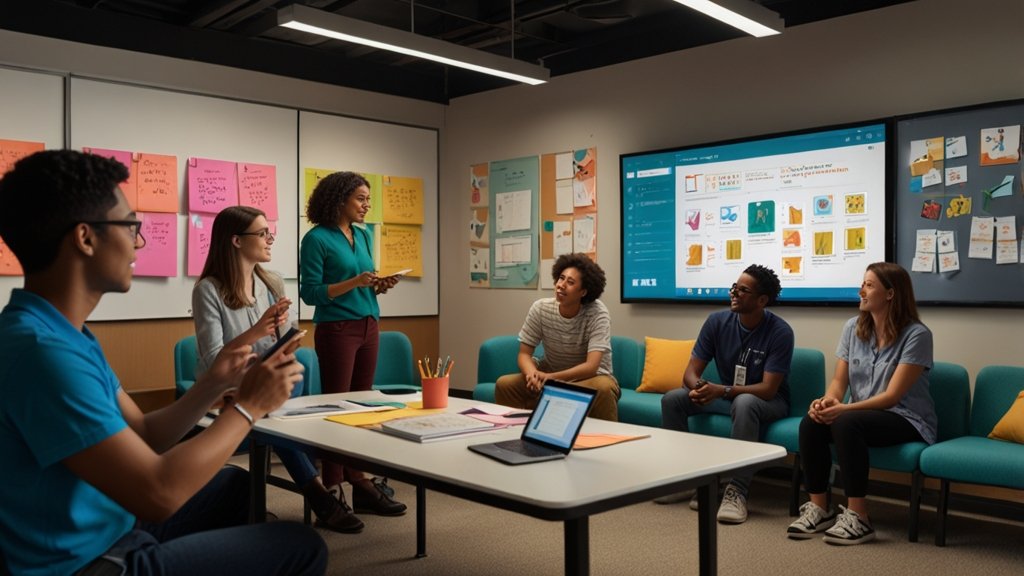Imagine this: A student, lost in the back row of a bustling 35-person classroom, doodles as the teacher’s voice fades into background noise. Their question goes unasked, their confusion unnoticed. Now, rewind. Picture that same student, deeply engaged in a vibrant discussion with four peers, a teacher kneeling beside them offering targeted guidance, while another group explores ancient Rome through VR headsets nearby. This isn’t a fantasy school; it’s the tangible reality of Classroom 15x. Forget everything you thought you knew about rigid rows and one-size-fits-all lectures. Classroom 15x is an educational revolution, intentionally limiting groups to around 15 students and masterfully blending cutting-edge tech with human-centered design to create learning experiences that finally click for everyone.
This isn’t merely shrinking class sizes. It’s a holistic reimagining – a potent cocktail of optimal group dynamics, purposeful technology, brain-science-backed strategies, and adaptable spaces designed to unlock potential. Classroom 15x directly tackles the frustrations of overcrowded, impersonal environments, replacing them with a dynamic ecosystem where personalized attention, collaboration, and genuine understanding flourish. Ready to see how education should feel? Let’s dive in.
Why “15x”? Unpacking the Core Principles
The “15” in Classroom 15x isn’t arbitrary magic. Research consistently points to smaller groups (typically 10-18 students) as the sweet spot for maximizing teacher-student interaction, fostering meaningful peer collaboration, and enabling effective personalized learning. But the “x”? That’s the multiplier effect – the transformative power that comes from how that group size is leveraged:
- The Human Connection Multiplier: With fewer students, teachers move from crowd control to learning facilitation. They have the bandwidth to truly know each learner – their strengths, struggles, and sparks. This enables targeted feedback, timely intervention, and the building of strong, supportive relationships crucial for confidence and risk-taking.
- The Engagement Multiplier: Large classes often default to passive lectures. Classroom 15x demands active participation. Students aren’t just receivers; they’re discussants, problem-solvers, creators, and collaborators. This intrinsic involvement dramatically boosts retention and deepens understanding.
- The Flexibility Multiplier: Fifteen is manageable enough to allow for fluid grouping and regrouping based on needs, projects, or learning styles, without descending into chaos.
The Classroom 15x Toolkit: Where Tech Meets Tactile
This model thrives on a strategic blend of physical and digital elements, each chosen to enhance, not overwhelm, the learning process:
- Modular Furniture: Forget bolted-down desks. Think lightweight tables on casters, easily configurable comfy seating pods, standing desks, and writable surfaces. This allows the space to morph instantly from a lecture setup to collaborative hubs to quiet individual work zones. Flexibility is built into the furniture’s DNA.
- Interactive Displays (Smartboards & Beyond): These aren’t just fancy projectors. They become dynamic collaboration canvases. Students can wirelessly share work from their tablets, manipulate virtual objects together, annotate in real-time, and save sessions for later review. The focus shifts from teacher-centric presentation to student-centered creation and interaction.
- 1:1 Devices (Tablets/Laptops): Used purposefully, not constantly. They enable personalized learning paths via adaptive software, instant research, multimedia creation (podcasts, videos), digital portfolios, and seamless access to cloud-based collaboration tools. Crucially, device use is task-specific and balanced with offline activities.
- Virtual Reality (VR) & Augmented Reality (AR): No longer sci-fi gimmicks. Imagine dissecting a virtual frog in Biology without the smell, walking through the Colosseum in History class, or manipulating complex 3D molecular structures in Chemistry. VR/AR provides unparalleled immersive experiences that solidify abstract concepts, spark curiosity, and cater to visual and kinesthetic learners. Use is strategic and scaffolded.
- Brain-Boosting Breaks & Micro-Learning: Recognizing attention spans, Classroom 15x integrates short, intentional breaks. These aren’t just recess; they might involve a quick 5-minute physical activity game, a collaborative puzzle related to the lesson, a mindfulness moment, or a fast-paced digital quiz (like Kahoot!) to reinforce key concepts. These “brain resets” combat fatigue and dramatically improve focus upon return.
The Classroom 15x Experience: Learning Reimagined
So, what does a typical session feel like inside Classroom 15x? It’s dynamic, responsive, and deeply personalized:
- The Launch: The teacher starts with a compelling hook – maybe a short VR teaser, a puzzling real-world problem projected on the smartboard, or a quick collaborative brainstorm using digital sticky notes.
- Flexible Flow: Students might then break into smaller groups based on pre-assessment data or choice:
- Group A: Works with the teacher at a central table on targeted skill development.
- Group B: Collaborates on a project using tablets for research and a writable surface for planning.
- Group C: Dives into an immersive VR simulation related to the topic, followed by a reflection discussion.
- Individual Focus Zone: A quieter area with noise-canceling headphones for a student needing deep concentration on a specific task or using adaptive learning software.
- Brain Boost Interlude: Midway through, a teacher-initiated “brain boost” – perhaps a quick standing stretch challenge or a 3-minute collaborative online vocabulary game – re-energizes everyone.
- Knowledge Synthesis & Sharing: Groups reconvene, sharing their discoveries, solutions, or creations. This could involve projecting work onto the smartboard, presenting findings, or facilitating a peer-teaching session.
- Reflection & Feedback: The session ends with structured reflection (digital journals, quick exit tickets) and clear, actionable feedback from the teacher and peers.
The Tangible Benefits: Why Classroom 15x Wins
The impact of this model extends far beyond mere novelty. It delivers measurable advantages:
- Deeper Conceptual Understanding: Personalized attention and varied modalities (VR, collaboration, direct instruction) ensure concepts aren’t just covered, but truly grasped.
- Enhanced Critical Thinking & Problem-Solving: Small group work and project-based learning naturally foster analysis, creativity, and solution-finding.
- Stronger Social-Emotional Skills: Collaborative projects, peer feedback, and a supportive environment build communication, empathy, and teamwork skills.
- Increased Student Agency & Ownership: Self-paced elements, choice in activities, and visible progress tracking empower students to take charge of their learning journey.
- Improved Teacher Efficacy & Satisfaction: Teachers regain the ability to teach effectively, build relationships, and witness genuine growth, reducing burnout.
- Future-Proofed Skills: Navigating technology responsibly, collaborating digitally, thinking critically, and adapting to change are core competencies nurtured daily.
Classroom 15x vs. Traditional Models: A Clear Contrast
| Feature | Traditional Classroom (25-35+ Students) | Classroom 15x (10-18 Students) |
|---|---|---|
| Primary Focus | Coverage of Curriculum | Mastery & Deep Understanding |
| Teacher Role | Lecturer, Disciplinarian | Facilitator, Mentor, Coach |
| Student Role | Passive Receiver | Active Participant, Creator, Collaborator |
| Interaction | Limited Teacher-Student; Minimal Peer Depth | High-Quality Teacher-Student; Rich Peer Collaboration |
| Pacing | Lockstep, Whole-Class | Flexible, Personalized & Group-Based |
| Environment | Static Rows, Fixed Furniture | Dynamic, Modular, Multi-Zone Spaces |
| Technology Use | Often Supplemental or Teacher-Centric | Integrated, Purposeful, Student-Driven |
| Differentiation | Challenging, Often Superficial | Intrinsic, Seamless, Deep |
| Engagement | Variable, Often Low | Consistently High & Active |
| Primary Challenge | Managing Behavior, Reaching All | Maximizing Potential of Each Interaction |
Implementing Classroom 15x: Beyond the Buzzword
Transitioning to Classroom 15x requires thoughtful planning, not just enthusiasm:
- Mindset Shift: This is a pedagogical transformation, not just a physical or tech upgrade. Professional development focusing on facilitation, personalized learning strategies, and tech integration within the small group context is crucial.
- Strategic Space Design: Invest in modular, flexible furniture. Create distinct zones (collaboration, quiet focus, direct instruction, tech immersion). Ensure easy access to power and seamless wireless connectivity.
- Purposeful Technology Selection: Choose tools that enhance the core pedagogy of small-group, active learning. Avoid tech for tech’s sake. VR/AR should have clear curricular links. Tablets need robust educational apps and management systems.
- Curriculum Reimagining: Move away from purely lecture-based delivery. Design units that leverage project-based learning, stations, workshops, and inquiry – formats that thrive in the Classroom 15x environment.
- Assessment Evolution: Rethink grading. Focus more on formative assessment, project rubrics, digital portfolios, and competency demonstrations that align with the active, collaborative nature of the model. Real-time feedback during small group work is powerful.
- Phased Implementation: Start small. Pilot Classroom 15x in one grade level or subject area. Gather feedback, iterate, and build success before scaling.
The Future is Flexible, Focused, and Human
Classroom 15x isn’t a rejection of technology; it’s a masterclass in using it wisely. It recognizes that the most powerful learning accelerators remain human connection, focused attention, and responsive teaching. By intentionally limiting group size to around 15, it creates the essential conditions for these elements to thrive. The strategic integration of modular spaces, smartboards, tablets, and VR becomes exponentially more effective within this manageable framework. The brain-boosting breaks aren’t distractions; they’re neuroscience-backed tools for sustained engagement.
This model addresses the core failures of the industrial-era classroom, offering a blueprint for education that is truly adaptive, engaging, and equitable. It empowers learners not just with facts, but with the critical thinking, collaboration, and self-directed learning skills essential for an unpredictable future. It empowers teachers to reclaim the art and joy of teaching.
Classroom 15x proves that sometimes, the most powerful innovations are about creating the right conditions for learning, not just adding more stuff. It’s about depth over breadth, connection over crowd control, and potential unlocked, one focused group of fifteen at a time. The future of learning isn’t just smaller; it’s smarter, more human, and exponentially more effective.
FAQs
Q: Isn’t Classroom 15x just a fancy name for small class sizes?
A: While small group size (around 15) is the foundation, Classroom 15x is much more. It’s the intentional leveraging of that size through flexible spaces, purposeful tech integration, brain-science strategies (like micro-breaks), and a pedagogical shift towards active facilitation and personalization. The “x” represents the multiplier effect of combining these elements strategically.
Q: How can schools afford the technology (VR, tablets, smartboards) for Classroom 15x?
A: Implementation can be phased. Start with core elements like modular furniture and robust Wi-Fi. Prioritize versatile tools (like tablets and a good interactive display) before investing in VR. Seek grants, community partnerships, and consider leasing options. Remember, the tech is a tool to enhance the pedagogy enabled by the small group size; it shouldn’t be the sole focus or budget drain.
Q: Does Classroom 15x work for all subjects and age groups?
A: The core principles (focused interaction, flexibility, active learning) benefit all ages and subjects. The implementation will vary. VR might be used more in science/history for older students, while tactile manipulatives and play-based learning zones might feature more prominently in early elementary within the flexible 15x space. The model adapts to developmental needs.
Q: How do you handle assessment and grading in such a dynamic, varied environment?
A: Classroom 15x naturally lends itself to authentic assessment. Teachers observe and give real-time feedback during small group work. Project rubrics, digital portfolios showcasing process and product, student self-reflections, and competency-based assessments become more prominent and meaningful than traditional tests alone.
Q: What about students who need a lot of quiet or get overwhelmed?
A: The flexible design of Classroom 15x is a major advantage. Dedicated quiet zones with noise-canceling options, breakout spaces, or even simple partitions allow students to self-regulate. Teachers, knowing students well in this smaller setting, can proactively guide them to environments where they learn best, fostering inclusion and reducing overwhelm.
Q: Is there evidence that Classroom 15x actually improves learning outcomes?
A: Research strongly supports the benefits of its core components: smaller class sizes (especially for younger/marginalized students) boost engagement and achievement; active learning strategies significantly improve retention and critical thinking over passive lectures; purposeful tech integration enhances specific skills and motivation. Classroom 15x synthesizes these evidence-based practices into a cohesive model.
Q: How does Classroom 15x prepare students for the future?
A: Beyond content knowledge, Classroom 15x explicitly cultivates future-ready skills daily: collaboration in diverse groups, problem-solving authentic challenges, communicating ideas effectively, using technology responsibly as a tool, self-directed learning, and adaptability within changing environments. These are the competencies valued in higher education and the modern workforce.








